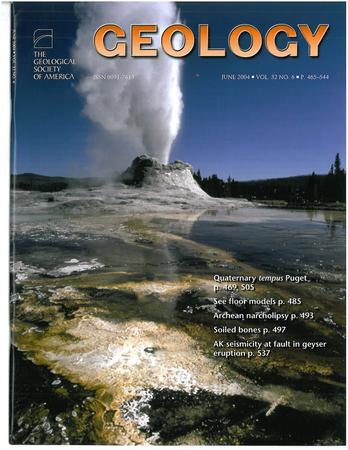马里诺冰期后的产热甲烷释放导致帽状白云岩中极贫13c方解石降水
IF 4.6
1区 地球科学
Q1 GEOLOGY
引用次数: 0
摘要
马里诺冰期是已知最严重的雪球地球气候事件之一,在约635 Ma突然结束,全球分布的盖层碳酸盐沉积物沉积在冰川沉积物上。盖层白云岩中方解石胶结物异常负的δ13C特征(δ13C = - 48‰~ - 41‰)证明了这一极端的全球变暖事件是由天然气水合物失稳释放的甲烷所致。然而,由于甲烷释放的时间和甲烷的来源尚不清楚,天然气水合物失稳假说存在争议。短句来源在华南盖层白云岩中,极贫13c (δ13C = - 51.9‰~ - 50.9‰)方解石降水发生的时间(618±5.8 Ma)远晚于Marinoan冰期结束,并与热成因甲烷释放有关,其中最贫13c的方解石的流体包裹体气体δ13C1值(- 38.7‰)和C1/(C2 + C3)比值支持了这一结果。我们的研究结果证明,盖层白云岩中方解石胶结物的极负δ13C特征与包合物不稳定无关,因此排除了这一机制作为马里诺雪球地球终止的原因。这项研究不仅完善了我们对埃迪卡拉纪碳循环的认识,而且对评价前寒武纪沉积盆地的生烃具有重要意义。本文章由计算机程序翻译,如有差异,请以英文原文为准。
Thermogenic methane release after Marinoan glaciation induced extremely 13C-depleted calcite precipitation in cap dolostones
The Marinoan glaciation was one of the most severe known Snowball Earth climate events, terminating abruptly at ca. 635 Ma with the deposition of globally distributed cap carbonate sediments overlying glacial deposits. This extreme global warming event has been attributed to methane release from the destabilization of gas hydrates, as supported by the abnormally negative δ13C signatures (δ13C = −48‰ to −41‰) of calcite cements that occur in the cap dolostones. However, the hypothesis of gas hydrate destabilization is controversial as the timing of methane release and the methane origin are not clear. Here, we demonstrate that extremely 13C-depleted (δ13C = −51.9‰ to −50.9‰) calcite precipitation occurred much later (618 ± 5.8 Ma) than the termination of Marinoan glaciation in the cap dolostones in South China, and it was associated with thermogenic methane release, as supported by a fluid inclusion gas δ13C1 value (−38.7‰) and the C1/(C2 + C3) ratio measured in the most 13C-depleted calcites. Our findings prove that extremely negative δ13C signatures of calcite cements in cap dolostones are unrelated to clathrate destabilization, thus excluding this mechanism as a cause for the termination of the Marinoan Snowball Earth. This study not only refines our understanding of Ediacaran carbon cycling but also has implications for evaluating hydrocarbon generation in Precambrian sedimentary basins.
求助全文
通过发布文献求助,成功后即可免费获取论文全文。
去求助
来源期刊

Geology
地学-地质学
CiteScore
10.00
自引率
3.40%
发文量
228
审稿时长
6.2 months
期刊介绍:
Published since 1973, Geology features rapid publication of about 23 refereed short (four-page) papers each month. Articles cover all earth-science disciplines and include new investigations and provocative topics. Professional geologists and university-level students in the earth sciences use this widely read journal to keep up with scientific research trends. The online forum section facilitates author-reader dialog. Includes color and occasional large-format illustrations on oversized loose inserts.
 求助内容:
求助内容: 应助结果提醒方式:
应助结果提醒方式:


